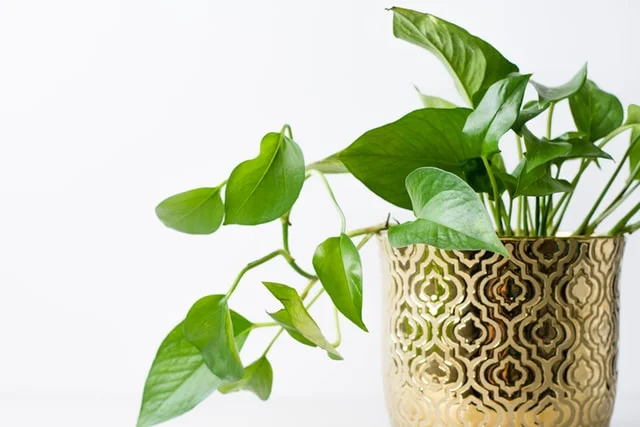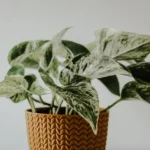There are several causes and solutions to leaf curling with the Pothos. In this article, we’ll be delving into some of the most common causes of leaf curling and offering some great solutions. There is even a BONUS solution right at the end, but you need to read all the others first- no skipping ahead.
Temperature. It should be constant and between 18-29F.
Pests. Kill them with booze, soap, or spray.
Underwatering. Water them more.
Root Rot. Move the plant to a new container.
Lack of light. Open the curtains
Table of Contents
Why your Pothos’ leaves are curling
Temperature
The first reason why your Pothos’ leaves might be curling is that the temperature is wrong. This could be either because the temperature is too low or because it’s too high.
Generally speaking, Pothos’ are reasonably adaptable to new environments. However, you will need to give them time to adapt. If they’re in a room where the temperature is changing all the time, they won’t adapt quickly enough.
In this situation, instead of surviving in any temperature, they won’t stay in any. Pothos can survive anywhere from 18-29F. However, this doesn’t mean you can quickly change the temperature and expect quick changes.
Pests
All plant growers and gardeners hate pests. Not only do they look terrible and sometimes spread disease, but they can also impact the growth and health of a plant.
Pests such as mealybugs, spider mites, slugs, and other animals will eat away at your plant. This means that instead of growing, your plant will need to make more repairs than usual, which will use up much-needed nutrients and energy.
Pests on leaves can quickly be sorted. However, pests on the stem, sucking out the sap? That’s where you need to take serious action.
Water
Like all other plants, Pothos’ like to be watered. These guys are so used to water that you can keep them in it!
But when you take away that water, it’s a matter of time before the leaves start curling. In an attempt to retain what little moisture they have, the leaves will begin to limp and wilt,
People keeping their Pothos’ in water probably won’t have this issue, but in soil, forgetting to water is a common problem. These are not succulents. They need water.
Root Rot- Fungus
Root rot is a common issue among many houseplants. However, in the case of Pothos, it’s more likely to be caused by a fungal infection.
This fungal infection can be spread from one plant to another. But it may also come from an outside source, such as a pest. When the roots are rotten, the plant can no longer absorb water. Instead of drinking the water, they will just sit in it. This creates the ideal condition for mould to grow.
Unable to absorb more water from the soil, the leaves will dry up in an attempt to retain what little moisture they have stored in them.
Root Rot- Too much nitrogen
Another common cause of root rot is overfeeding. All plants need nitrogen. However, too much and the roots can get clogged.
When the small leaves start changing colour, that is a sign that your plant is getting too much nitrogen.
When there is a build-up of salt and nitrogen in the soil, it will clog the plant’s pores, and the water surrounding it won’t be drunk up. It will simply sit around. As previously mentioned, when water is unable to be absorbed, it will start to create mould.
Sunlight
With Pothoses, it’s super important to make sure they get enough light. All plants need sunlight for photosynthesis, it’s how they get their energy.
And when we say sunlight, we mean sunlight. Artificial lights (like your bedroom light) will not have the required UV rays that your plant needs to carry out photosynthesis.
In the absence of light, the leaves will curl up in an attempt to face what little light there is available. For a plant, a lamp is useless. They need natural light from the sign.
If this isn’t available, you will need to use a UV light.
But, if natural light isn’t available in your home, where the heck are you living?!?!
Solutions to Pothos leaves curling
Temperature
If the issue is temperature, the best place to keep your Pothos is inside. Here, you can control the temperature much better. Mother nature can have a habit of changing her mind every 10 minutes.
Once inside, you will need to sort out any drafts. Use a draft blocker, draft tape, whatever you need to. Just make sure any wind from outside doesn’t go inside.
You should also try to keep your plants in a different room to your Air Conditioner units and heating units.
Pests
There are several ways to deal with pests. Here are 3 of my favourites. I know it’s not lovely killing living things, but if you want your plant to survive, you gotta do what you gotta do.
1. Rubbing alcohol. This alcohol would kill a human if they drank it. Imagine what it will do to a bug! Just rub your plant with it, and no bug will want to touch it.
2. Dishwashing soap and liquid. Creating a soap and water barrier between the plant and the bug will prevent it from touching. If you were covered in bugs, I’m sure you would wash your hands to get them off. The same can be applied to your plant.
3. Bug spray. Simple easy. Most garden shops sell it. Just give your plant a spray and watch the bugs fall dead.
Water
If the problem is a lack of water, the solution will, of course, be to water it more often than you do. Unlike some plants, it’s tough to overwater a Pothos. As soon as the soil is dry, you need to give it another heavy water.
If you don’t want to water your plant, you can even leave this one in water. That’s the great thing about it. It makes an excellent plant for an aquarium. If you’re not keeping it in water, you will need to make sure to add plenty to the soil you are keeping it in.
Root Rot
If your Pothos has root rot, whatever the cause, you will need to move it to a new pot. I’m afraid the soil that it used to live in will have to go in the bin.
Take it out of the pot, and brush the soil away from the roots. If it’s just one lousy root, you can cut it off! Then, place it into a new pot with a bit of fresh soil in the bottom. Finally, pack the rest of the pot up with soil.
Whatever you did last time to cause root rot, don’t do it again. Feed it less, or keep the pests away.
Feeding
Once in a new pot, you will still need to feed it. A lack of feeding can also cause the leaves to curl. But how often do you need to feed it?
Depending on the size, you will usually only need to give your Pothos some more food once to four times a year. You will need to feed it a bit more often in water, but it doesn’t starve in soil.
In the wild, Pothos has thousands of other plants to share fertilizer with. In your home, it needs to be careful about how much it eats.
Sunlight
If your Pothos’ leaves are curling because of a lack of light, there really is only one solution here… Open the damn curtains.
Well, I say only one. There are actually several. If you always keep the curtains open, think about which rooms in your house get the most sunlight. Your Pothos will be happiest in these rooms. But even in these rooms, they won’t get any of that precious light if you don’t open the curtains.
If you absolutely have to, you could even use a UV light.
BONUS SOLUTION
Cut off the bad leaves
If the issue is just one leaf, the best solution could be to just cut it off. I know that sounds like cheating, but who cares?
When you cut it off, make sure to use sharp and clean tools. If a plant is struggling to share water, energy or nutrients throughout the whole plant, cutting off a bit of the plant will make the “whole plant” that bit smaller.
Think of it this way. If 1/50 leaves are malnourished, surely it will be better to feed 49 leaves properly? Although this won’t work if many leaves have started curling.
Conclusion
And there we have all of the causes and solutions to leaves curling on the Pothos Plant. Remember, this kind of thing happens. A bit of curling here and there doesn’t mean that you’ve failed as a plant parent, it just means that there is something not quite right, and now, you need to sort it out.
As soon as the issue has been sorted, you can go back to having a beautiful, leafy plant that brings a bit of greenery to your home.
If this has sparked your interest, why not check out some of our other articles on Pothoses?
Photo by Kelsey Brown on Unsplash



